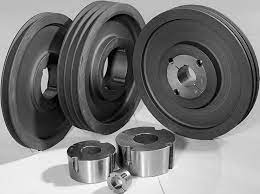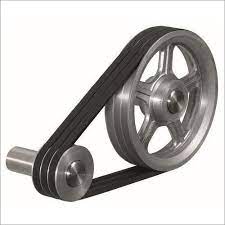Product Description
Product Description
Aluminum/C45 Timing Belt Pulley
| Product Name | Aluminium Timing Pulley MXL XL L H XH XXH T2.5 T5 T10 AT5 AT10 S2M S3M S5M S8M GT2 GT3 GT5 3M 5M 8M Tooth timing Belt Pulley | |
| Teeth profile | Trapezoidal toothed | MXL, XXL, XL, L, H, XH, XXH |
| T-toothed | T2.5, T5, T10, T20 | |
| Arc toothed | HTD3M, HTD5M, HTD8M, HTD14M, HTD20M, Gt2, Gt3, Gt5 | |
| S-toothed | S2M, S3M, S4.5M, S5M, S8M, S14M | |
| Parabolic-toothed | P2M, P3M, P5M, P8M, P14M | |
| Y-toothed | G2M, G3M, G5M, Y8M | |
| Teeth Quantity | 10-150 teeth or customized | |
| Inner Bore | 2-200mm H7 precision or customized | |
| Belt width | 4mm, 6mm, 9mm, 10mm, 12mm, 15mm, 20mm, 25mm, 30mm, 40mm, 50mm, 1/4”, 5/16”, 3/8”, 1/2”, 3/4”, 1”, 1.5”, 2”or customized | |
| Material | carbon steel C45, Aluminum 6061, 6082 | |
| Surface treatment | Anodize,Black Oxide,Phosphate, Galvanization, Nitriding, Dichromate | |
Detailed Photos
Timing pulley used on conveyor roller
Workshop
Equipments:
Lathe machine, Hobbing machine,Drilling machine,CNC machine,Milling machine, etc
FAQ
Q1: Are you trading company or manufacturer ?
A: We are factory.
Q2: How long is your delivery time and shipment?
1.Sample Lead-times: 10-20 days.
2.Production Lead-times: 30-45 days after order confirmed.
Q3: What is your advantages?
1. The most competitive price and good quality.
2. Perfect technical engineers give you the best support.
3. OEM is available.
| Certification: | ISO |
|---|---|
| Pulley Sizes: | Timing Belt Pulley |
| Manufacturing Process: | Hobbing Teeth |
| Material: | Aluminum |
| Surface Treatment: | Anodizing |
| Application: | Chemical Industry, Grain Transport, Mining Transport, Power Plant |
| Customization: |
Available
| Customized Request |
|---|

What are the maintenance requirements for belt pulleys in industrial settings?
In industrial settings, proper maintenance of belt pulleys is essential to ensure their optimal performance, longevity, and safe operation. Here’s a detailed explanation of the maintenance requirements for belt pulleys in industrial settings:
1. Regular Inspection: Belt pulleys should be inspected regularly to identify any signs of wear, damage, or misalignment. Inspect the pulleys for cracks, corrosion, excessive wear on the grooves, or any other visible abnormalities. Check for proper alignment by examining the position of the pulleys relative to each other and their corresponding belts. Regular inspections help detect issues early on and prevent further damage or failures.
2. Lubrication: Proper lubrication is crucial for the smooth operation of belt pulleys. Lubricate the pulley bearings according to the manufacturer’s recommendations. This helps reduce friction, heat generation, and wear on the bearings. Use the appropriate lubricant and follow the recommended lubrication intervals to ensure optimal performance and extend the life of the pulleys.
3. Tension Adjustment: Maintaining proper belt tension is vital for the efficient and reliable operation of belt pulleys. Check the tension of the belts regularly using the manufacturer’s guidelines or recommended tensioning devices. Adjust the tension as needed to ensure the belts are neither too loose nor too tight. Proper tensioning allows for effective power transmission, minimizes belt slippage, and reduces wear on the belts and pulleys.
4. Belt Replacement: Over time, belts may wear out or become damaged. Regularly inspect the belts for signs of wear, cracking, fraying, or excessive stretching. If any of these issues are present, replace the belts promptly with new ones of the correct size and type. Using worn or damaged belts can lead to reduced performance, increased risk of pulley damage, and potential system failures.
5. Cleaning: Keep the belt pulleys clean and free from debris, dust, and dirt that may accumulate over time. Use appropriate cleaning methods, such as brushing or compressed air, to remove any contaminants that could affect the pulley’s performance or the grip of the belts. Clean pulleys contribute to better belt traction, reduce the risk of slippage, and improve overall system efficiency.
6. Alignment Correction: Proper pulley alignment is crucial for efficient power transmission and to prevent premature wear. If misalignment is detected during inspections or if the belts are not running smoothly, take corrective measures to align the pulleys correctly. Use alignment tools, such as laser alignment devices, to ensure precise alignment of the pulleys. Proper alignment minimizes belt wear, reduces noise and vibration, and extends the life of the pulleys and belts.
7. Safety Measures: When performing maintenance on belt pulleys, always adhere to safety procedures. Follow lockout/tagout protocols to isolate the equipment from power sources before inspecting or working on the pulleys. Use appropriate personal protective equipment (PPE) to protect against potential hazards. Ensure that maintenance personnel are trained in safe maintenance practices and are familiar with the specific procedures for working with belt pulleys.
8. Record Keeping: Maintain a record of maintenance activities and inspections performed on belt pulleys. This includes dates of inspections, lubrication, tension adjustments, belt replacements, and any corrective actions taken. Keeping a maintenance log helps track the history of maintenance activities, identify recurring issues, and plan future maintenance tasks effectively.
In summary, the maintenance requirements for belt pulleys in industrial settings include regular inspections, proper lubrication, tension adjustment, belt replacement, cleaning, alignment correction, adherence to safety measures, and maintaining a maintenance record. By following these maintenance requirements, industrial facilities can ensure the optimal performance, longevity, and safe operation of belt pulleys, contributing to the overall efficiency and reliability of their industrial processes.

How do belt pulleys handle variations in load capacity and speed?
Belt pulleys are designed to handle variations in load capacity and speed by providing flexibility and adjustability in power transmission systems. They offer several mechanisms to accommodate changes in load and speed requirements. Here’s a detailed explanation of how belt pulleys handle variations in load capacity and speed:
1. Load Capacity: Belt pulleys can handle variations in load capacity through the selection of appropriate belt materials, pulley sizes, and belt tension. When the load increases, the belt tension can be adjusted to ensure proper power transmission. By increasing the tension, the grip between the belt and pulley increases, allowing for the transfer of higher loads. Belt materials with higher tensile strength and load-bearing capacity can also be chosen to handle heavier loads.
2. Speed Variation: Belt pulleys offer the ability to handle variations in speed through different mechanisms:
a. Fixed Speed Ratios: In applications where a fixed speed ratio is required, belt pulleys of specific sizes are selected to achieve the desired speed ratio. By choosing pulleys with different diameters or numbers of grooves, the speed of the driven pulley can be adjusted relative to the driving pulley, resulting in the desired speed variation.
b. Variable Speed Pulleys: Variable speed pulleys, also known as adjustable or variable pitch pulleys, enable continuous speed control. These pulleys feature movable pulley halves or arms that change the distance between the grooves. By adjusting the position of the movable pulley, the effective diameter of the pulley changes, altering the speed ratio. This allows for stepless speed variation within a defined range, providing flexibility in adjusting the speed of the driven system.
c. Step Pulleys: Step pulleys have multiple grooves of different diameters on the same pulley. By changing the belt position between these grooves, the speed ratio can be adjusted. Step pulleys provide a range of predetermined speeds by selecting the appropriate groove, allowing for different speed settings suitable for various operations.
d. Motor and Pulley Size Selection: By selecting motors and pulleys of different sizes or using different combinations of belt pulleys, the speed of the driven system can be adjusted. This is commonly seen in applications where multiple speed options are required, such as in drill presses or lathes, where a range of speeds is needed for different cutting operations.
Overall, belt pulleys handle variations in load capacity and speed by offering flexibility in belt tension, selecting appropriate pulley sizes and materials, utilizing variable speed pulleys, employing step pulleys, and choosing motor and pulley combinations to achieve the desired speed ratios. These mechanisms allow for efficient power transmission in a wide range of applications with varying load and speed requirements.

Can you explain the different types of belt pulleys and their applications?
There are several different types of belt pulleys, each designed for specific applications and requirements. The choice of pulley type depends on factors such as the power transmission needs, speed control requirements, space limitations, and the type of belt or rope used. Here’s an overview of some common types of belt pulleys and their applications:
1. V-Belt Pulleys: V-belt pulleys are one of the most widely used types of pulleys. They have a trapezoidal groove profile and are designed to accommodate V-belts, which have a corresponding cross-sectional shape. V-belt pulleys are commonly used in applications that require high torque transmission, such as in industrial machinery, automotive engines, and HVAC systems.
2. Flat Belt Pulleys: Flat belt pulleys have a flat or slightly crowned surface without any grooves. They are used with flat belts, which have a rectangular cross-section. Flat belt pulleys are suitable for applications that require high-speed power transmission, such as in textile machines, printing presses, and conveyor systems.
3. Timing Belt Pulleys: Timing belt pulleys, also known as synchronous pulleys, have teeth or grooves that mesh with the teeth of a timing belt. This design provides precise and synchronous power transmission, making them suitable for applications that require accurate positioning and timing, such as in robotics, CNC machines, and automotive engines.
4. Variable Speed Pulleys: Variable speed pulleys, also called adjustable or variable pitch pulleys, allow for continuous speed control by adjusting the effective diameter of the pulley. They feature movable pulley halves or arms that change the distance between the grooves, altering the speed ratio. Variable speed pulleys are used in applications where adjustable speed control is required, such as in machinery with variable loads or in variable speed drives.
5. Step Pulleys: Step pulleys have multiple grooves of different diameters arranged on the same pulley. By changing the belt position between these different grooves, the speed ratio can be adjusted. Step pulleys are commonly used in machines such as drill presses, lathes, and milling machines, where a range of predetermined speeds is required for different operations.
6. Idler Pulleys: Idler pulleys are not directly involved in power transmission but are used to redirect and tension the belt. They help maintain proper belt tension, improve belt wrap around the pulleys, and assist in achieving the desired belt path. Idler pulleys are commonly used in automotive engines, HVAC systems, and other belt-driven systems.
7. Clutch Pulleys: Clutch pulleys are specialized pulleys that incorporate a clutch mechanism. They allow for on-demand engagement and disengagement of the pulley from the driven shaft. Clutch pulleys are commonly used in automotive applications, such as in alternators, where they enable efficient power generation while reducing drag during idle or deceleration.
It’s important to note that these are just a few examples of belt pulley types, and there may be other specialized designs based on specific application requirements. The selection of the appropriate belt pulley type depends on factors such as the power transmission needs, speed control requirements, load capacity, and the type of belt or rope used.
In summary, different types of belt pulleys, such as V-belt pulleys, flat belt pulleys, timing belt pulleys, variable speed pulleys, step pulleys, idler pulleys, and clutch pulleys, are designed for specific applications and requirements. Understanding the characteristics and applications of these pulley types allows for the proper selection and utilization of belt pulleys in various mechanical systems.


editor by CX
2023-11-21














